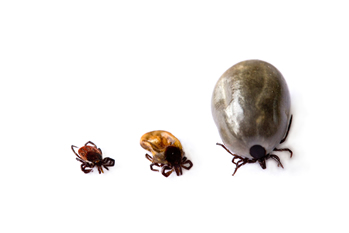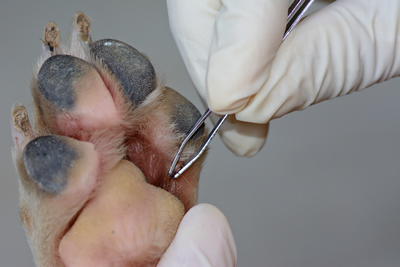Tick Disease
 Creepy Crawlers
Creepy Crawlers
Ticks are ugly creatures, aren’t they? Slowly, laboriously and surreptitiously they creep around and show up in the most surprising of places. We are all told that everything in nature has some sort of meaning and use. But ticks – not sure about their good & beneficial side.
When we opened the practice here some 35 years ago, we saw boatloads of fleas, and virtually no ticks. Over time this relationship has reversed. Now we don’t see as many fleas (but we see enough). And now we see an ever increasing number of, and problems with, ticks.
Some Tick Info
There are a number of different kinds of ticks which live in New Jersey and the East Coast.
Ticks transmit a number of different disease producing agents (called pathogens) & these include: protozoa, viruses, bacteria, & rickettsia. Ticks are arthropod ectoparasites, and they feed on (and only on) the blood of their hosts. In the insect world, they are closely related to spiders, mites, & scorpions.
 While strong geographic preferences exist for some ticks, the ranges (where they live) for ticks in general is expanding. Hence, the incidence of tick disease in America is expanding all the time. And now we even have to worry about ticks and tick diseases coming from abroad, i.e. from across the world (invasive tick species – and hence, new & foreign diseases).
While strong geographic preferences exist for some ticks, the ranges (where they live) for ticks in general is expanding. Hence, the incidence of tick disease in America is expanding all the time. And now we even have to worry about ticks and tick diseases coming from abroad, i.e. from across the world (invasive tick species – and hence, new & foreign diseases).
More animals are getting ‘co-infections’, which means an animal (dog, etc.) is becoming infected with more than one tick transmitted disease. This is occurring because some ticks carry more than one disease (ticks are ‘co-infected’), and/or also because an animal can be bitten by multiple and different ticks, each tick carrying a different tick disease.
Not all ticks look the same. Different ticks have different appearances. Then, depending on which tick life stage you see (i.e. larva, nymph, or adult), and whether the adult tick is a male or female, each and all have different appearances. So, don’t waste your time trying to identify a particular tick. We counsel our clients that all ticks are bad, and potentially disease producing. Repeat – all ticks are bad & potentially disease producing.
Moose
Ticks cause much problem with disease in animals and people. Did you know that we are losing some of the moose in the Northeast because they are dying from an overwhelmingly heavy tick burden. It has been determined by wildlife biologists that some of these moose harbor up to 100,000 ticks on one moose. Incredible. Then these moose are unable to maintain their homeostasis, and they die.

 Lyme Disease
Lyme Disease
First we saw no particular disease issue with the increasing tick population. Then people and dogs began to get ill. It was determined there was a disease called Lyme disease, transmitted by ticks, which caused these illnesses.
Lyme disease is caused by a spirochete bacteria, and it is now the most commonly diagnosed vector-borne disease in humans in the world. Vector-borne means a carrier agent, usually an arthropod, transfers the infective agent from one host to another. In the United States, the eastern seaboard and upper midwestern states report the most Lyme disease.
It is called Lyme disease because in 1976 there was a geographic clustering of cases in children in Lyme, Connecticut, of a multisystemic disease process thought, at the time, to be juvenile rheumatoid arthritis. It was later determined this problem was caused by Lyme disease.
Oh, by the way– it’s called Lyme disease – not ‘Lymes disease’.
 Tick Diseases
Tick Diseases
All over the world, different ticks carry a number of different diseases. Here in Hunterdon County and in New Jersey, we have observed and learned that ticks are carrying more and more bad diseases. At current time in Hunterdon County & New Jersey, ticks are responsible for carrying & transmitting the following 5 diseases in dogs & people:
- Lyme disease (Lyme borreliosis – Borrelia burgdorferi)
- anaplasmosis (Anaplasma phagcytophilum)
- ehrlichiosis (Ehrlichia spp.)
- Rocky Mountain spotted fever (Rickettsia rickettsia)
- babesiosis (Babesia spp.)
 Given the current mobility of people, pets, and products, it is highly likely that ticks in Hunterdon County & New Jersey will carry new/additional tick diseases in the future.
Given the current mobility of people, pets, and products, it is highly likely that ticks in Hunterdon County & New Jersey will carry new/additional tick diseases in the future.
A number of different kinds of ticks carry the above 5 diseases. Some ticks can carry more than one type of disease. Ticks vary morphologically a great deal according to life stage and gender. Hence it is not important to try to identify a tick as a ‘deer tick’ or whatever. We counsel our clients to think of all ticks as bad & potentially problem causing.
![]() Prevention
Prevention
We recommend to apply an approved, name brand tick product to dogs and to cats who go outside. We recommend this 12 months per year. Yes, some ticks are active/present during the winter. Most tick products are topical – liquid material usually applied to the back of the neck.
We recommend Lyme vaccination for dogs.


